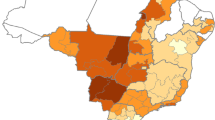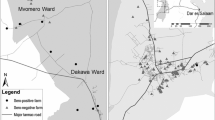Abstract
There have been no surveys of the cattle population for brucellosis in the Pacific Island Countries and Territories (PICTs) for more than 15 years. This study used disease surveillance as a capacity building training tool and to examine some of the constraints that impede surveillance in PICTs. The study also developed and implemented a series of surveys for detecting antibodies to B. abortus in cattle in Fiji, Papua New Guinea, Vanuatu and the Solomon Islands contributing to OIE requirements. The findings indicated lack of funds, lack of technical capacity, shortage of veterinarians, high turnover of in-country officials and lack of awareness on the impacts of animal diseases on public health that were constraining active disease surveillance. During the development and implementation of the surveys, constraints highlighted were outdated census data on farm numbers and cattle population, lack of funds for mobilisation of officials to carry out the surveys, lack of equipment for collecting and processing samples, lack of staff knowledge on blood sampling, geographical difficulties and security in accessing farms. Some of the reasons why these were constraints are discussed with likely solutions presented. The detection surveys had the objectives of building capacity for the country officials and demonstrating freedom from brucellosis in cattle for PNG, Vanuatu and the Solomon Islands. PNG, Vanuatu and the Solomon Islands all demonstrated freedom from bovine brucellosis in the areas surveyed using the indirect ELISA test. Fiji had an outbreak of brucellosis, and the objective was to determine its distribution and prevalence on untested farms. The Muaniweni district surveyed during the training had a 95 % confidence interval for true prevalence between 1.66 and 5.45 %. The study showed that active disease surveillance could be used as a tool for training officials thus, improves surveillance capacity in resource poor countries.

Similar content being viewed by others
References
Atalupe, H., 2014. Personal communication, Deputy Director, Livestock Department, Ministry of Agriculture and Livestock Development, PO Box G13, Honiara, Solomon Islands.
Australian National University, 2015. Maps Online. ANU College of Asia & the Pacific, The Australian National University, Canberra.
Borja, L., 2014. Personal communication, Dr Leo Borja, Senior Veterinary Officer. Veterinary Pathology Laboratory, P.O. Box 77, Koronivia, Fiji.
Brioudes, A., Warner, J., Hedlefs, R., Gummow, B., 2014. A review of domestic animal diseases within the Pacific Islands region. Acta tropica 132, 23.
Cameron, A., 1999. Survey Toolbox for Livestock Diseases. Australian Centre for International Agricultural Research.
Cannon, R.M., Roe, R.T., 1982. Livestock disease survey: a field manual for veterinarians. Bureau of Range Science, Department of Primary Industry. Australian, Government Publishing Service, Canberra.
Cokanasiga, K., 2015. Personal communication from the Former Director for the Animal Health and Production Division, Ministry of Agriculture, Fiji, currently Deputy Director, Trade and Agribusiness, Land Resources Division, Secretariat of the Pacific Community.
Ducrotoy, M., J., Bertu, W., J., Reuben, A.O., Amahyel, M.G., Ward, B., Sue, W., Ignacio, M.n., 2014. Brucellosis as an emerging threat in developing economies: lessons from Nigeria. PLOS Neglected Tropical Diseases Journal, 18.
FAO, 1999. Manual on livestock disease surveillance and information systems. FAO Regional Office for Asia and the Pacific, 39 Phra Athit road, Bangkok.
FAO, 2009. U.S. & Thai governments launch Asia’s first program to train veterinarians to investigate animal disease outbreaks that could spread to humans. FAO Regional Office for Asia and the Pacific, 39 Phra Athit road, Bangkok, http://www.fao.org/asiapacific/news/detail-events/en/c/45947/ (accessed on 19/11/15).
FAO, 2016a. Conducting a PRA training and modifying PRA tools to your needs. FAO Regional Office for Asia and the Pacific, 39 Phra Athit road, Bangkok.
FAO, 2016b. Grazing livestock in the South West Pacific. Viale delle Terme di Caracalla, 00153 Rome, Italy
Fiji Report, 2014. Suva, Fiji http://www.tourismfiji.com/fiji-weather.html (13/11/2015).
Fletcher, S., Gero, A., Thiessen, J., Willetts, J., Rumsey, M., Daly, J., Buchan, J., Kuruppu, N., 2013. Understanding the Pacific’c adaptive capacity to emergencies in the context of climate change: country Report Fiji. Institute for Sustainable Futures, and WHO Collaborating Centre, University of Technology, Sydney, p. 35.
Gall, D., Nielsen, K., 2004. Serological diagnosis of bovine brucellosis: a review of test performance and cost comparison. Rev. sci. tech. Off. int. Epiz., 2004, 23 (3), 989-1002, 14.
Gummow, B., 2010. Challenges posed by new and re-emerging infectious diseases in livestock production, wildlife and humans. Livestock Science 130, 41–46, 6.
Gummow, B., 2014. Food Animal Biosecurity Network Project Final Report. Discipline of Veterinary Science, James Cook University, Townsville 4811, Queensland, Australia, p. 31.
Jakob, Z., Esther, S., Felix, R., Bassirou, B., Don, d.S., Marcel, T., 2007. Human benefits of animal interventions for zoonosis control. Emerging Infectious Diseases, Vol. 13, No. 4, 5.
Kutoslowo, A., 2014. Personal communication, Livestock Officer, Livestock Department, P.M. B 9095, Airport Road, Port Vila, Vanuatu.
Macfarlane, D., 2009. Country Pasture/Forage Resource Profiles Report. David Macfarlane Consulting, Unit 2/120 Ryan St, West End 4101, Brisbane, Australia p. 16.
Martin, T., Epstein, V., 1999. The animal health status of the Salomon Islands. Secretariat of the Pacific Community, Suva Regional Office, Suva, Fiji, p. 44.
Monica, C., Rhonda, S., 2011. The Pacific Island Countries Fiji, Papua New Guinea (PNG), Samoa, Solomon Islands, Vanuatu and Tuvalu. University of South Australia, University of South Australia, GPO Box 2471, Adelaide, South Australia 5001, Australia.
Mosese, N., 2014. Personal communication, Senior Livestock Officer, Livestock Department, P.M.B 9095, Airport Road, Port Vila, Vanuatu.
Muhammad, S., Masood, R., Ali Ahmad, S., Mansoor, d., Ahmad,, Abdul, R., 2011. Prevalence of Bovine Brucellosis in Organized Dairy Farms, Using Milk ELISA, in Quetta City, Balochistan, Pakistan. Research Veterinary Medicine International, Article ID 358950, 3 pages, doi:10.4061/2011/358950, 4.
OIE, 2012a. Guidelines for animal disease control. World Organisat ion for Animal Health (OIE), 2012.
OIE, 2012b. Standards for bovine bucellosis tests. OIE Terrestrial Manual OIE, 12, rue de Prony, 75017 Paris, France, p. 35.
OIE, 2013. WAHID interface; http://www.oie.int/en/animal-health-in-the-world/oie-listed-diseases (accessed 29/04/2014).
OIE, 2015a. OIE Member countries. World Organisation for Animal Health 12, rue de Prony, 75017 Paris, FRANCE, http://www.oie.int/index.php?L=3&id=103 (accessed on 18/11/15).
OIE, 2015b. Terrestrial Animal Health Code, World Organisation for Animal Health, protecting animals, preserving our future. World Organisation for Animal Health 12, rue de Prony, 75017 Paris, FRANCE, Telephone: 33-(0)1 44 15 18 88, Fax: 33-(0)1 42 67 09 87, E-mail: oie@oie.int, www.oie.int, p. 434.
Philips, R., 2014. Personal communication, Senior Veterinary Officer, Biosecurity Vanuatu, P.M.B 9095, Airport Road, Port Vila, Vanuatu.
Puana, I., 2015. End of project report, animal disease surve illace in Vanuatu, Pacific Community (SPC), 3 Luke Street, Nabua, Fiji, p. 62.
Secretariat of the Pacific Communitiy, 2009. Policy Brief, Livestock in the Pacific. Secretariat of the Pacific Community, Secretariat of the Pacific Community, Private Mail Bag Suva, Fiji Islands, p. 4.
Thrusfield, M., 1995. Veterinary Epidemiology, Second Edition ed. Blackwell Science Pty Ltd, 54 University Street, Carlton, Victoria 3053, Australia.
Tukana, A., Warner, J., Hedlef, R., Gummow, B., 2015. The history of brucellosis in the Pacific Island and its re-emergence. Prev. Vet. Med Journal.
WHO, 2007. Regional meeting on zoonotic diseases report. World Health Organisation, Regional Office for South-East Asia, World Health House, Indraprastha Estate, Mahatma Gandhi Marg, New Delhi, Delhi 110002, India, p. 51.
World Vision Report, 2015. Country Profile: Vanuatu. http://www.worldvision.com.au/ (accessed on 18/11/2015).
Acknowledgments
The authors wish to thank the following people for their collaboration and assistance: Mr Tomasi Tunabuna (Deputy Permanent Secretary, Ministry of Agriculture) in Fiji and Dr Leo Borja (Senior Veterinary Officer) of the Animal Health and Production Division in Fiji. Mr Andrew Yamanea (Managing Director), Dr Nime Kapo (Chief Veterinary Officer), Mr Andy Yombo (Senior Epidemiologist) and Dr Peter Wai’in (Laboratory Manager) in Kila Kila, all of the National Agricultural Inspection Authority in Papua New Guinea. Mr Lonny Bong (Director Livestock), Mr Nambo Moses (Senior Livestock Officer), Mr Alain Kutoslowo (Livestock Officer), Dr Peter Hoyle (Senior Veterinary Officer, Santo), Dr Roger Phillip (Senior Veterinary Officer, Port Vila) of the Livestock Department in Vanuatu. Mr Barney Keqa (Director Livestock), Mr Hearly Atapule (Deputy Director Livestock), Dr Emma Rooke (Chief Veterinary Officer) of the Livestock Department in the Solomon Islands. The authors also thank Professor Jeffrey Warner (College of Public Health, Medical and Veterinary Sciences, James Cook University, Townsville, Australia) for his role in the project which enabled the development of the study and the Secretariat of the Pacific Community, i.e. the Animal Health and Production team advisor, Dr Ken Cokanasiga for the support provided to the project. Finally, the authors also thank the Australian Aid program (AusAid agreement no. 57668) for approving and supporting the research technically and financially.
Author information
Authors and Affiliations
Corresponding author
Ethics declarations
Consideration for animal and human ethics was incorporated in the questionnaires for the surveys using the James Cook University policy guidelines. Ethical approval to carry out the study was obtained from the human and animal ethics committees at the university (approval reference: A1740).
Conflict of interest
The authors declare that they have no competing interests.
Rights and permissions
About this article
Cite this article
Tukana, A., Hedlefs, R. & Gummow, B. Brucella abortus surveillance of cattle in Fiji, Papua New Guinea, Vanuatu, the Solomon Islands and a case for active disease surveillance as a training tool. Trop Anim Health Prod 48, 1471–1481 (2016). https://doi.org/10.1007/s11250-016-1120-8
Received:
Accepted:
Published:
Issue Date:
DOI: https://doi.org/10.1007/s11250-016-1120-8




